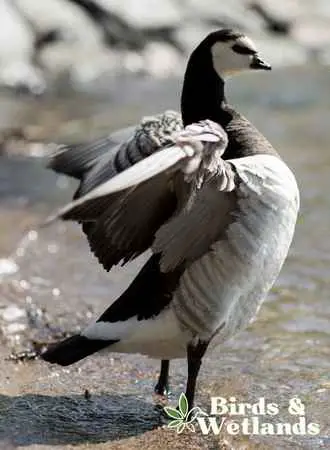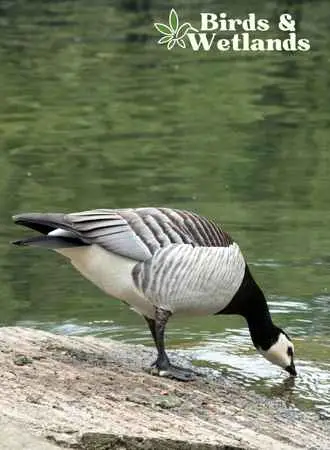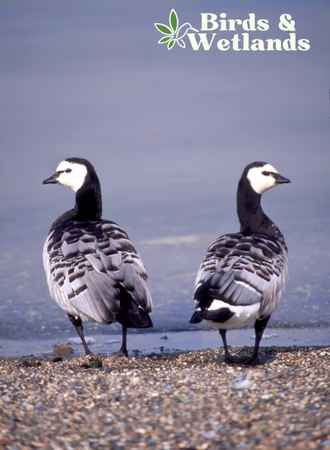The Arctic tundra is a harsh environment. Birds, mammals, insects and all manner of life must adapt to survive. The geese that breed in the Arctic have some amazing adaptations to help them live in this challenging place.
Let’s learn more about these extremely cold-adapted birds. See our guide to geese in Alaska here.
Key Points
Snow and barnacle geese are among the most common waterfowl that breed in the Arctic.
The reason why barnacles nest on cliffs is to protect their eggs from predation.
Many goslings need to dive off a cliff even though they still don’t know how to fly so they can reach the ground to eat with their parents.
The Arctic tundra is a harsh environment that requires special adaptations to survive.
Geese that nest in the Arctic have some amazing adaptations, including Barnacle geese that nest high up on cliffs.
The changing climate affects barnacle geese by forcing them to migrate further and faster to reach their wintering grounds. Despite these challenges, the barnacle goose has proven remarkably resilient.
Snow geese can be a problem for other species because they outcompete them for space and resources. However, they are not considered rare or endangered animals.
What geese live in the Arctic?
Barnacle Goose
The barnacle goose is a species of goose that is known for its unique breeding behavior. Unlike most other geese, it does not breed on land but instead chooses to use rocky islands and coastal cliffs as its breeding grounds.
Barnacle geese breed primarily on Arctic islands in the northern Atlantic, including Greenland, Iceland, Svalbard, and the Færoes. They prefer to nest close to the coast, often settling on small offshore islands with few predators.

Snow Goose
The snow goose is a highly distinctive North American bird species that breed at high altitudes in locations such as Greenland, Canada, Alaska, and Siberia, where conditions are generally harsh and snowy. During the winter months, snow geese migrate to more temperate regions in North America, such as southwestern British Columbia and parts of the U.S. They can often be seen along migration routes or coastal areas near their breeding grounds.
Why do Barnacle Geese nest high up on cliffs?
Barnacle geese are notable for their distinctive white and black plumage and unusual nesting behavior. These birds build their nests high up on cliffs to avoid predators such as arctic foxes. It is thought that this strategic location helps to keep the birds safe from harm, as it prevents terrestrial carnivores such as foxes and wolves from accessing them easily.
Additionally, nest sites that are elevated off the ground can stay cooler during hotter months and warmer during colder months. Due to these advantages, barnacle geese have long favored nesting in high locations rather than closer to ground level, where they would be more vulnerable to attack.

Why do Barnacle geese jump off Arctic cliffs?
Many people have marveled over the seemingly brave and foolhardy behavior of young barnacle geese, whose parents deliberately push them off steep cliffs to start their lives. However, there is a very good reason for this behavior: Life in the Arctic can be harsh and unpredictable, with brutally cold temperatures and challenging terrain that necessitate strategic nesting habits.
A few days after the chicks hatch, they are faced with a series of new challenges that they must overcome to successfully mature into adulthood. For one thing, they must leave the relative safety of their nests so that young geese can feed on grass, which the adults cannot provide for them. To achieve this goal, day-old chicks must carefully leap off the high ledges or cliffs where they were born, often hundreds or even thousands of feet above ground level. It is estimated that only 50% of the chicks survive.
There is an 8-minute video made by Hostile Planet on the website of National Geographic showing three barnacle geese chicks or goslings dropping into free fall hundreds of feet to reach their next meal. And there’s another video on Youtube narrated by Sir David Attenborough showing a young barnacle goose taking a leap. It is truly fascinating to watch these birds survive an extreme plunge to start their lives.

What are the natural predators of the barnacle goose?
The barnacle goose is a migratory bird that encounters many natural predators. Its main predators are falcons, polar bears, and Arctic foxes, all of which hunt the geese for food.
Falcon attacks often occur during migration season, as falcons relentlessly pursue the migrating flocks in search of an easy meal.
Polar bears also prey on the geese on land near areas of Arctic ice, using their powerful jaws to snatch whole flocks of geese and swallow them whole.
Arctic foxes rely on stealth to take down individual birds from within a flock. These sly predators often stalk young geese or goslings in the wild and capture them.
Despite these rather formidable predators, the barnacle goose has adapted and survived thanks to its natural survival instincts and impressive flying skills.
How does the changing climate affect barnacle geese?
Climate change on Earth has a significant impact on the barnacle goose and other animals that migrate seasonally between the Arctic and temperate regions.
As temperatures in the Arctic continue to rise, many barnacle geese must travel further and faster to reach their wintering grounds. To speed up their migration, they make fewer stops along the way, which can sometimes have negative consequences.
For example, during their spring migration, barnacle geese may arrive in the Arctic before there is adequate food available or when ground conditions are less favorable for landing.
Despite these challenges, the barnacle goose has proven remarkably resilient and adaptive to the changing climate, thanks to its incredible navigational abilities and powerful flapping wings.

Why are snow geese a problem?
Snow geese are a common fixture of Arctic landscapes, nesting and raising their young each summer. Despite their ubiquity, these birds can have a negative impact on the ecosystem due to their large population and nesting habits.
Snow geese specifically pose a problem for breeding habitats shared by other species. They outcompete other birds for space and resources, often overwhelming breeding areas and causing damage to the tundra in the process. This disruption can have ripple effects that reach far beyond the breeding area to impact species higher up in the food chain, such as caribou.
Because of these impacts, it is important to understand geese migration patterns and keep careful track of their populations to develop strategies for mitigating any harmful effects they may have on their ecosystems.
How rare is a snow goose?
Snow geese are found in various habitats throughout North America, from forests and grasslands to wetland areas. While they can be difficult to spot in some of these environments due to their shy nature, they are also very abundant where they occur. In particular, large flocks of snow geese may form when migrating and wintering areas overlap. Because these birds regularly feed on grain and agricultural crops, their numbers can sometimes become problematic for farmers. However, despite the high densities of snow geese at times, they are not considered rare or endangered animals and are still relatively common across much of their range.

Why is the early spring bad for the barnacle geese?
The early spring can be difficult for many species, with unpredictable weather and harsh conditions putting pressure on populations. But for the barnacle geese, the early season is actually a boon.
Barnacle geese are closely associated with coastal environments and feed mainly on algae and other sea plants. Early spring means more food in this ecosystem, allowing more goslings to survive into adulthood due to less competition for food from other bird species who might crowd the early sprouting plants out.
While the years with an early spring maybe get off to a bumpy start for these geese, in the long term, they thrive due to their adaptability to changing conditions.


